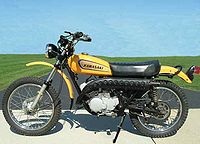Difference between revisions of "Hatta fork"
| Line 1: | Line 1: | ||
[[Image:1971 Kawasaki F7.jpg|thumb|200px|right|Kawasaki F7 showing Hatta forks]] | |||
[[Image:Hatta Fork02.jpg|thumb|190px|right|Hatta fork capable of increasing rake]] | [[Image:Hatta Fork02.jpg|thumb|190px|right|Hatta fork capable of increasing rake]] | ||
[[Image:Hatta Fork01.jpg|thumb|180px|right|Hatta fork capable of decreasing rake]] | [[Image:Hatta Fork01.jpg|thumb|180px|right|Hatta fork capable of decreasing rake]] | ||
'''Hatta forks''' were a unique design of forks utilized by [[Kawasaki]] motorcycles from 1971 through 1975. These forks allowed the rider to customize the rake, spring tension, and fork length. | '''Hatta forks''' were a unique design of forks utilized by [[Kawasaki]] motorcycles from 1971 through 1975. These forks allowed the rider to customize the rake, spring tension, and fork length. | ||
Kawasaki models with Hatta forks: | Kawasaki models with Hatta forks: | ||
*[[Kawasaki F7|Kawasaki F7 175cc Enduro]] (1971-1975) | *[[Kawasaki F7|Kawasaki F7 175cc Enduro]] (1971-1975) | ||
*[[Kawasaki F5|Kawasaki F5 350cc "Bighorn"]] (1970-1971) | *[[Kawasaki F5|Kawasaki F5 350cc "Bighorn"]] (1970-1971) | ||
*[[Kawasaki F8|Kawasaki F8 250cc "Bison"]] (1971-1972) | *[[Kawasaki F8|Kawasaki F8 250cc "Bison"]] (1971-1972) | ||
==3 way axle== | ==3 way axle== | ||
The bottom of each leg of the forks have two positions for the axle. By placing the axle in the auxiliary position forward of the standard position increased the rake. By rotating the legs 180° so the auxiliary axle position is behind of the standard axle slot, decreased the rake. This gave Hatta forks a total of three positions for the axle. | The bottom of each leg of the forks have two positions for the axle. By placing the axle in the auxiliary position forward of the standard position increased the rake. By rotating the legs 180° so the auxiliary axle position is behind of the standard axle slot, decreased the rake. This gave Hatta forks a total of three positions for the axle. | ||
| Line 14: | Line 15: | ||
The upper and lower triple clamps were designed to permit even more adjustment. Both triple clamps had straight through holes as opposed to tapered at the top. This permitted the fork tubes to be raised or lowered to the rider's comfort. | The upper and lower triple clamps were designed to permit even more adjustment. Both triple clamps had straight through holes as opposed to tapered at the top. This permitted the fork tubes to be raised or lowered to the rider's comfort. | ||
[[Category:Kawasaki]] | [[Category:Kawasaki motorcycles]] | ||
Revision as of 17:14, 15 March 2009
Hatta forks were a unique design of forks utilized by Kawasaki motorcycles from 1971 through 1975. These forks allowed the rider to customize the rake, spring tension, and fork length. Kawasaki models with Hatta forks:
- Kawasaki F7 175cc Enduro (1971-1975)
- Kawasaki F5 350cc "Bighorn" (1970-1971)
- Kawasaki F8 250cc "Bison" (1971-1972)
3 way axle
The bottom of each leg of the forks have two positions for the axle. By placing the axle in the auxiliary position forward of the standard position increased the rake. By rotating the legs 180° so the auxiliary axle position is behind of the standard axle slot, decreased the rake. This gave Hatta forks a total of three positions for the axle.
Spring tension
The spring tension rate and damping was adjustable via an adjusting screw at the top of each leg under rubber caps.
Fork length
The upper and lower triple clamps were designed to permit even more adjustment. Both triple clamps had straight through holes as opposed to tapered at the top. This permitted the fork tubes to be raised or lowered to the rider's comfort.


